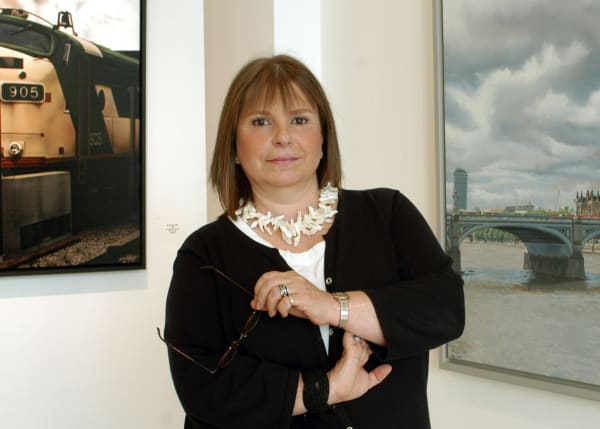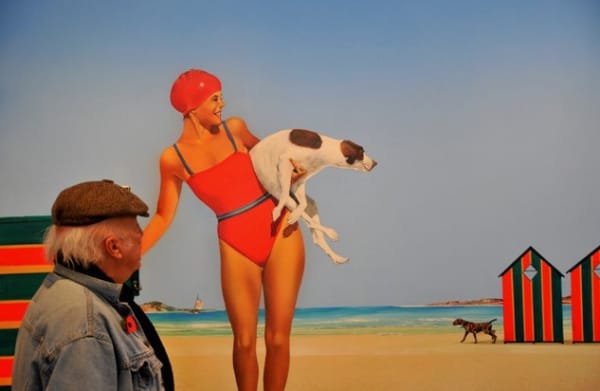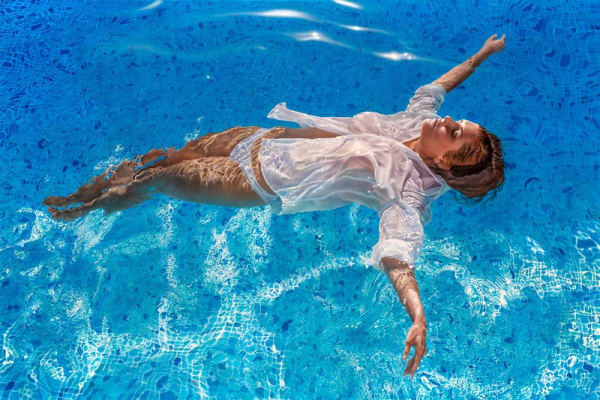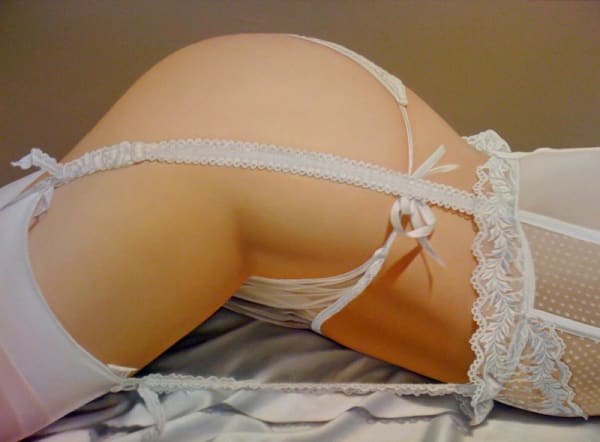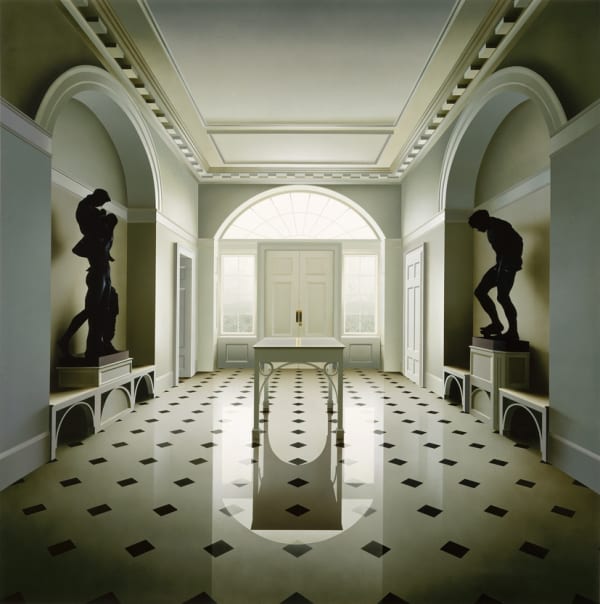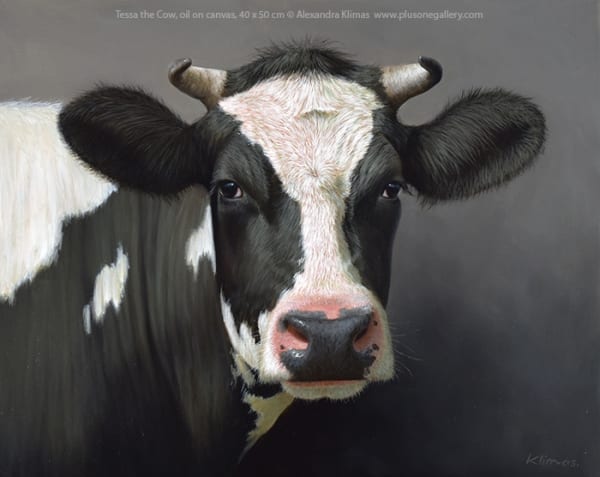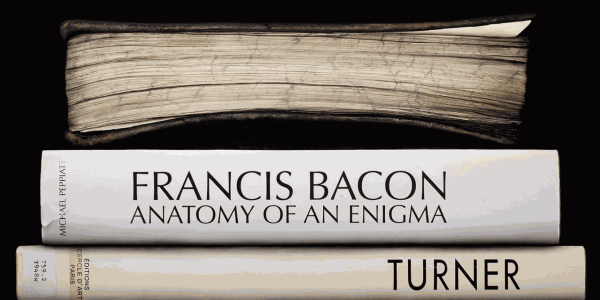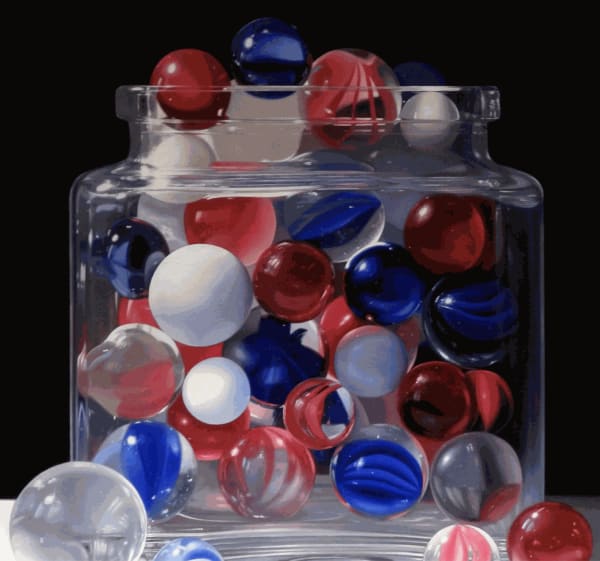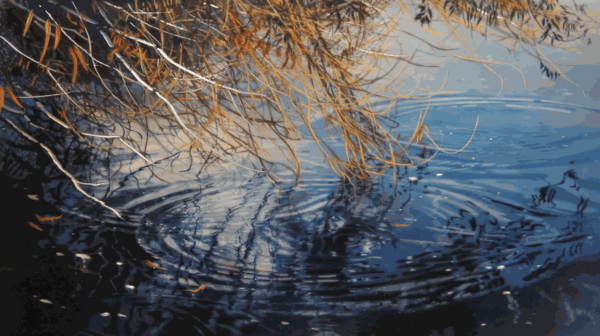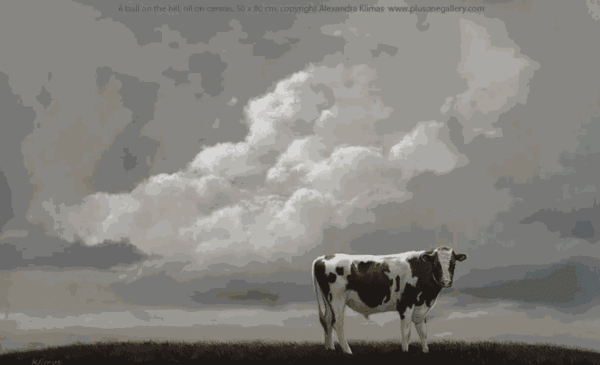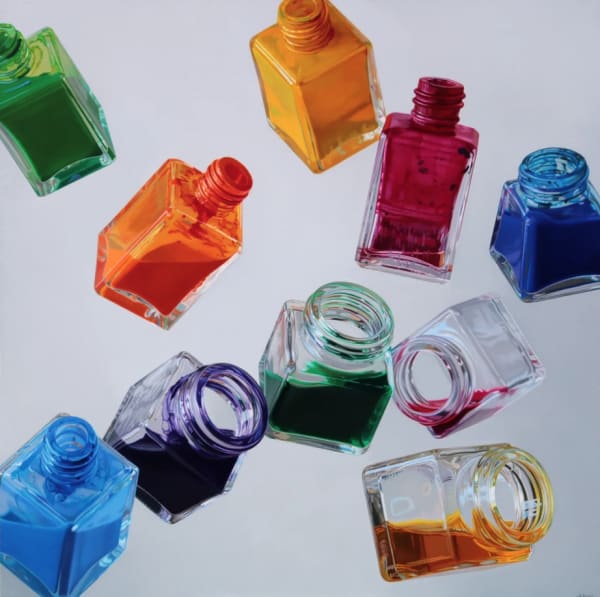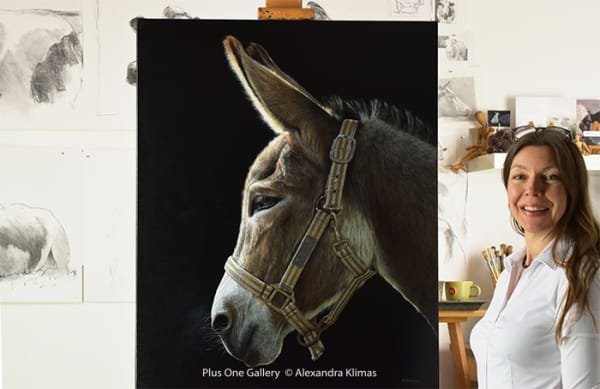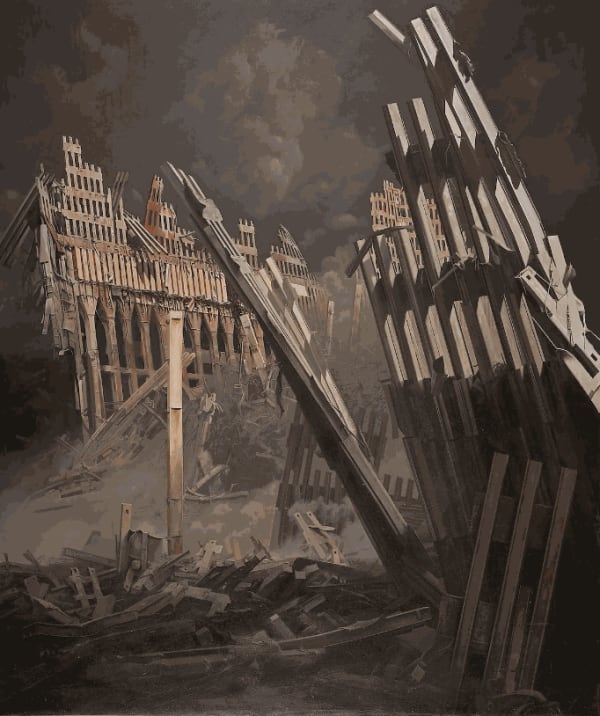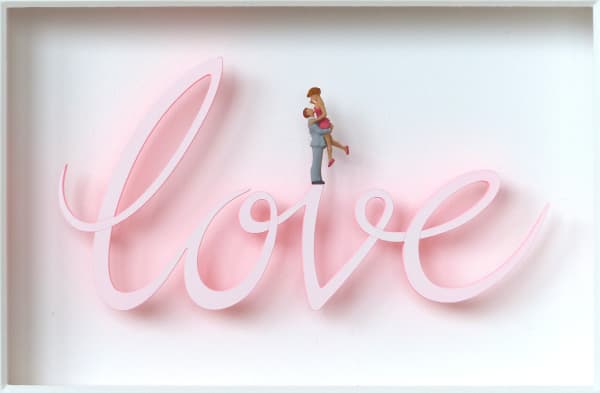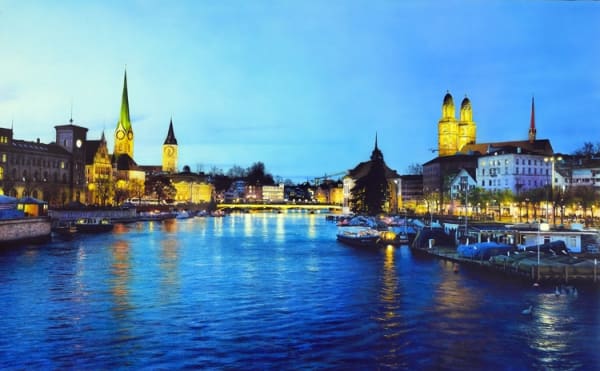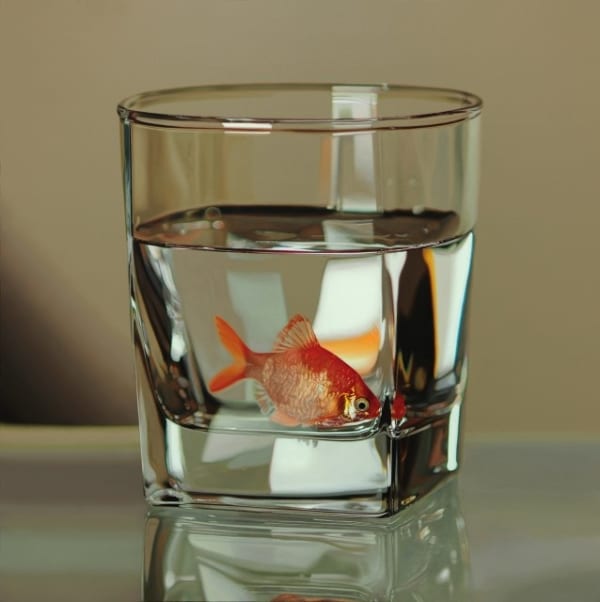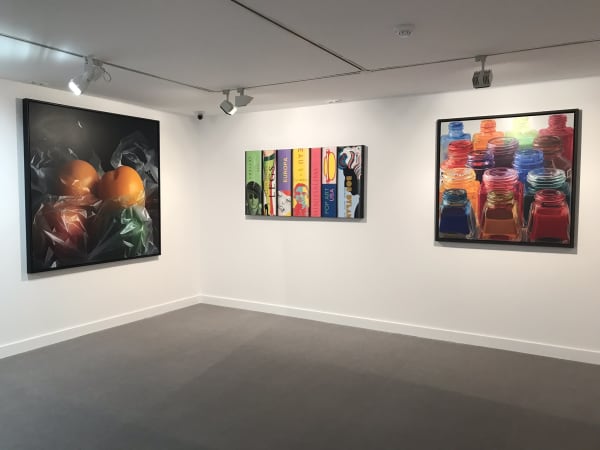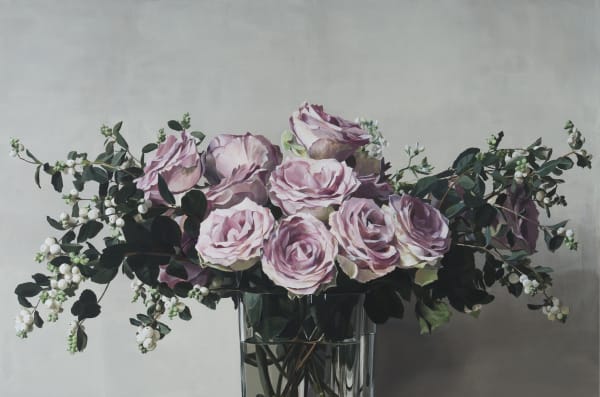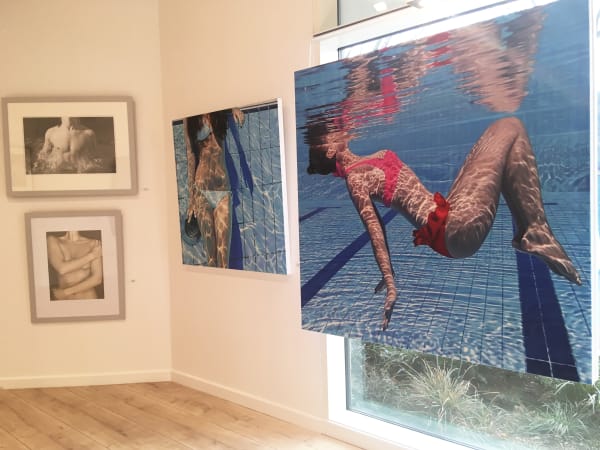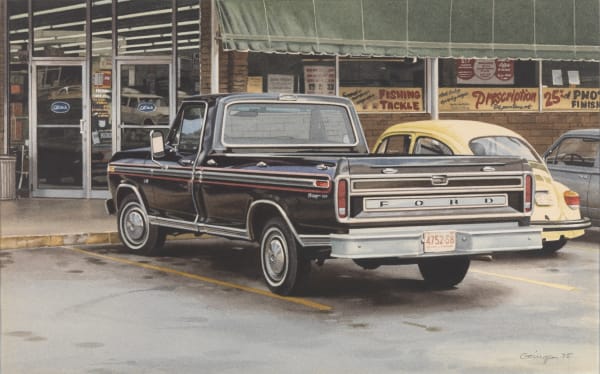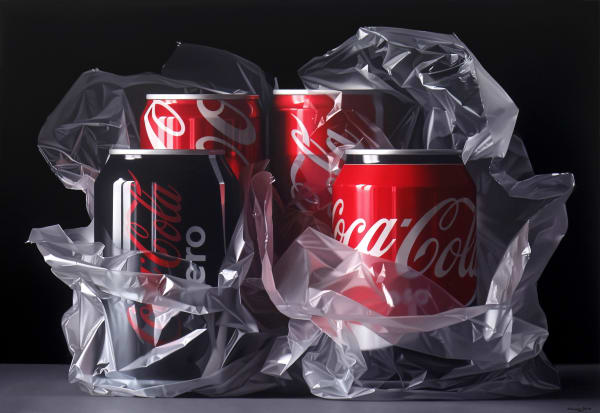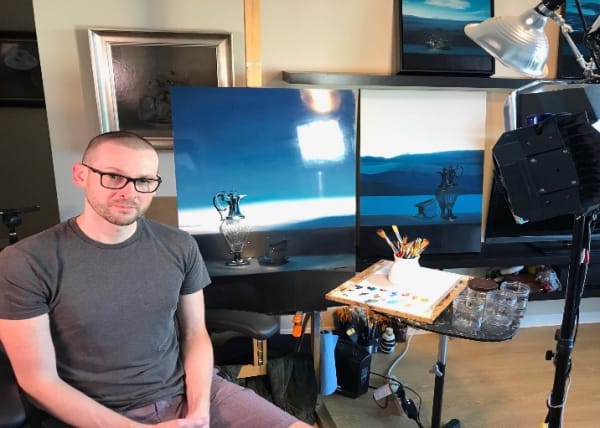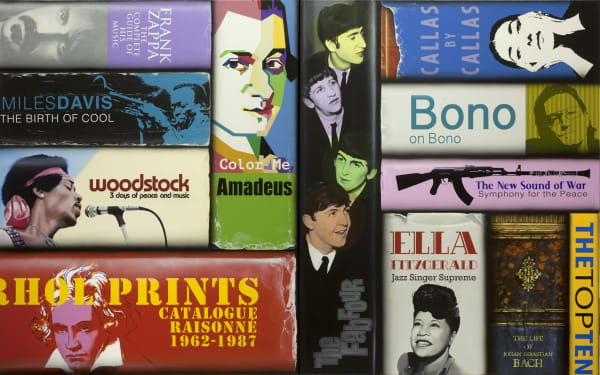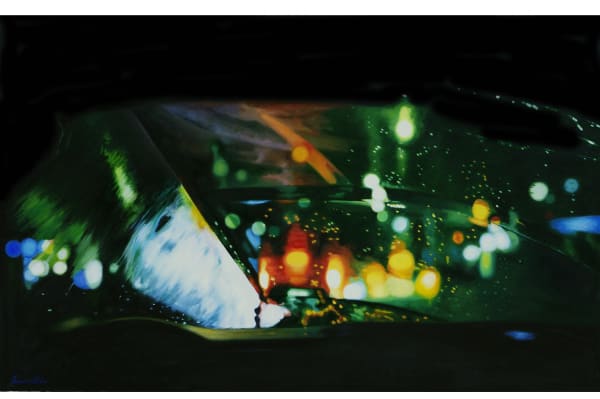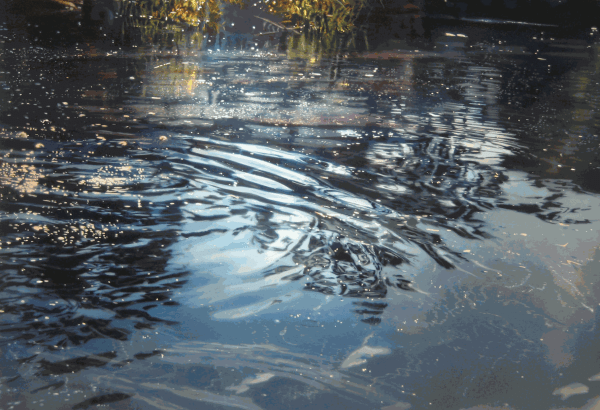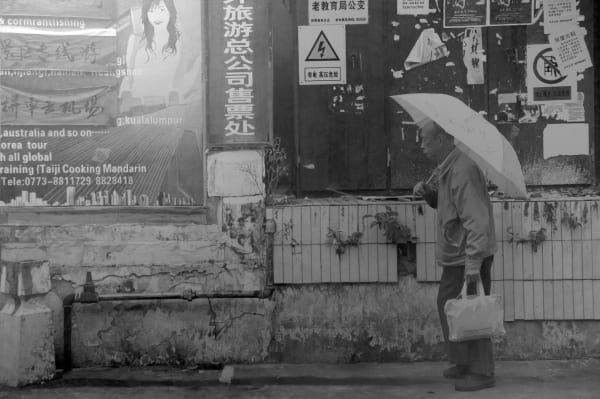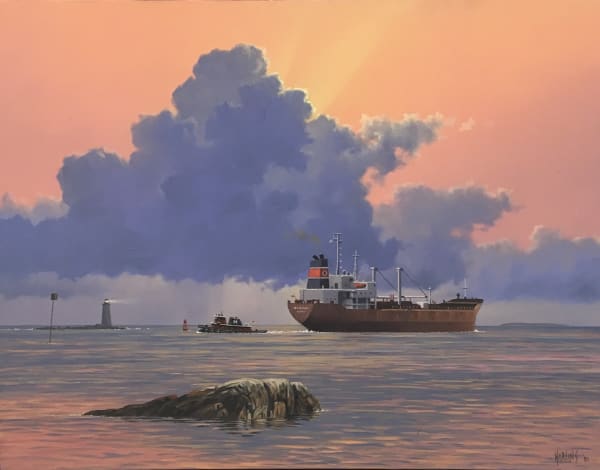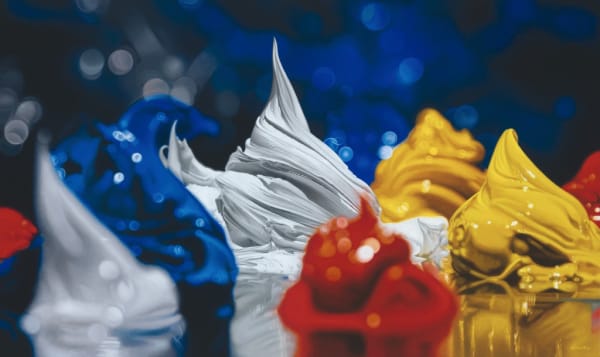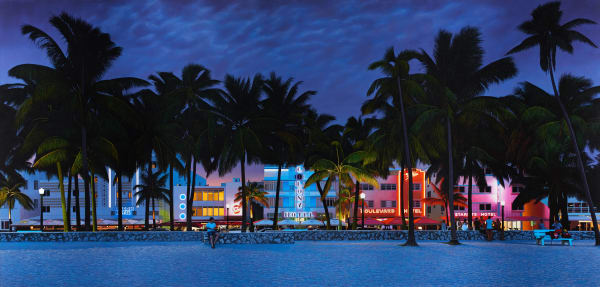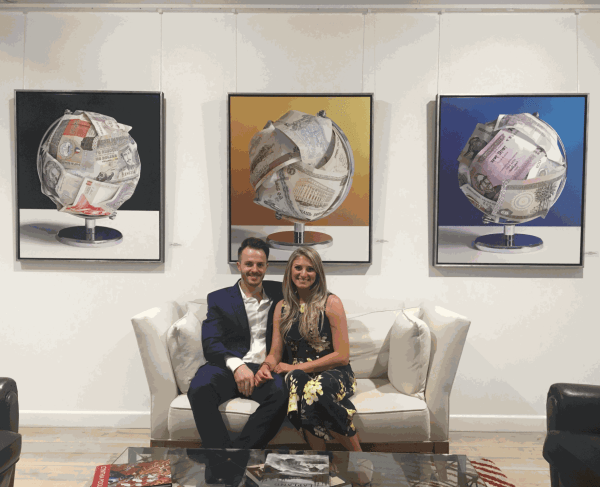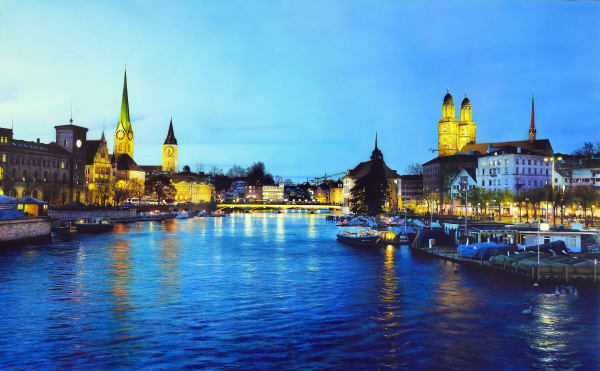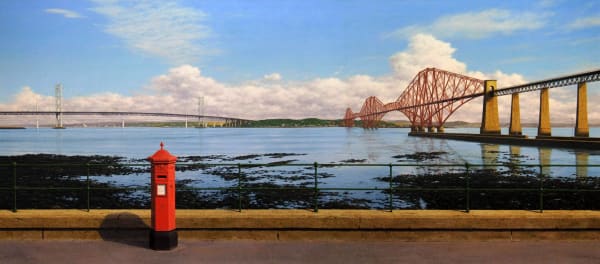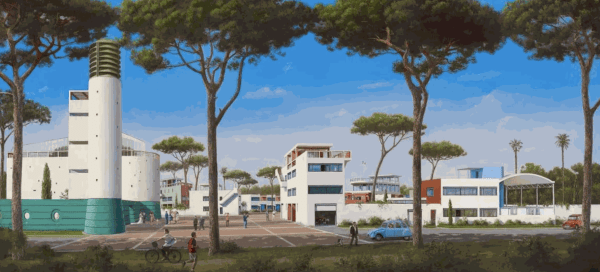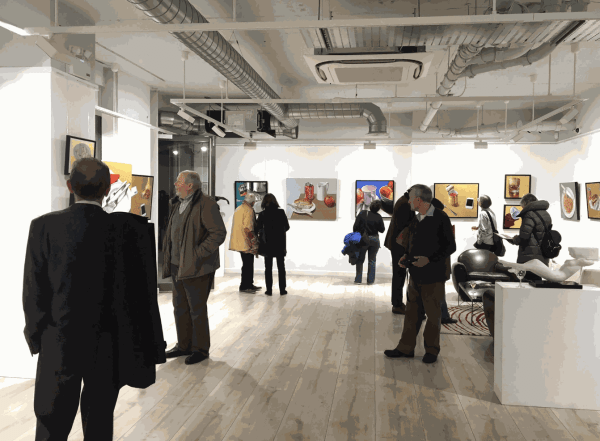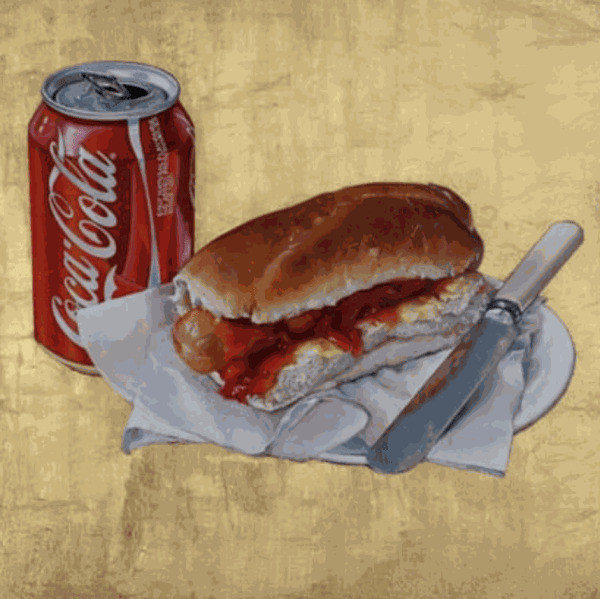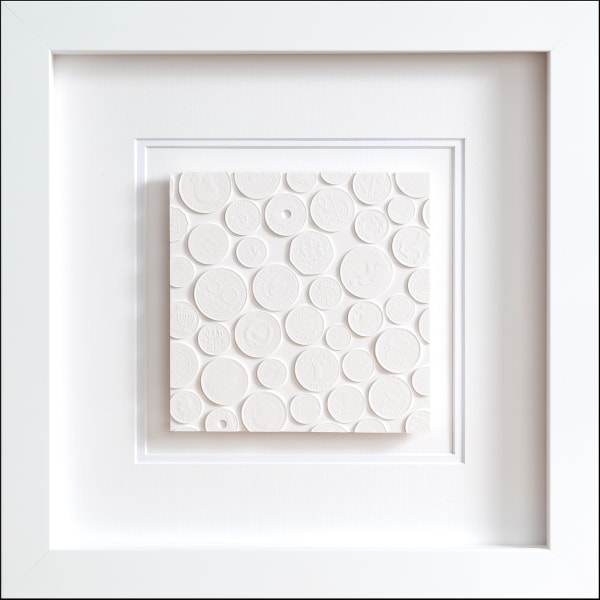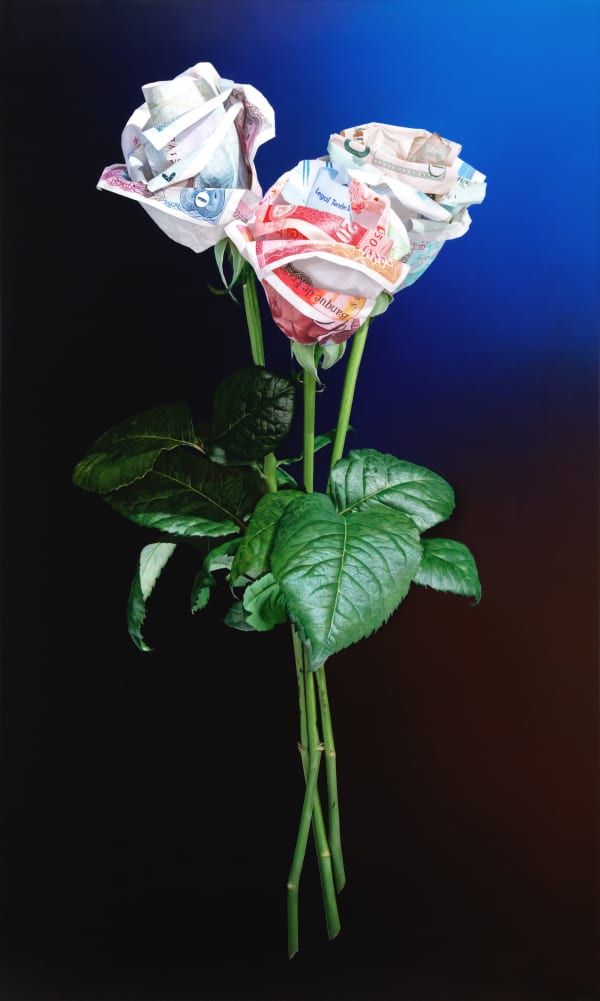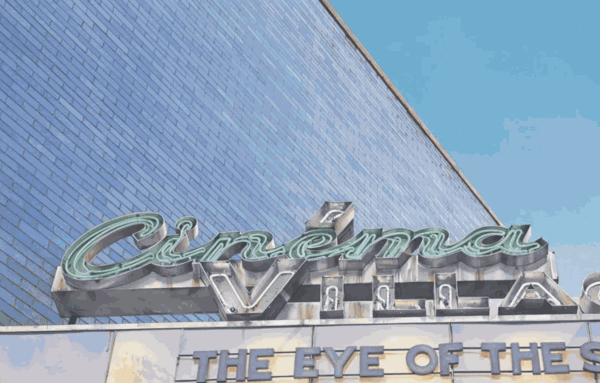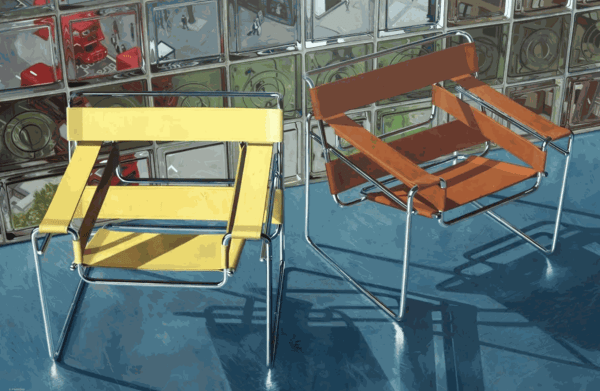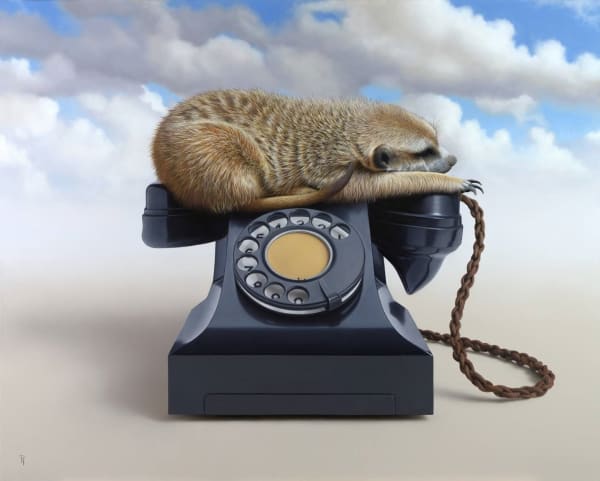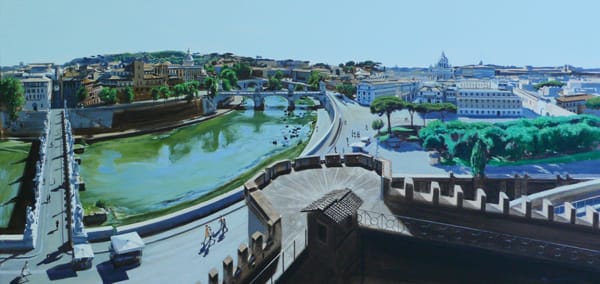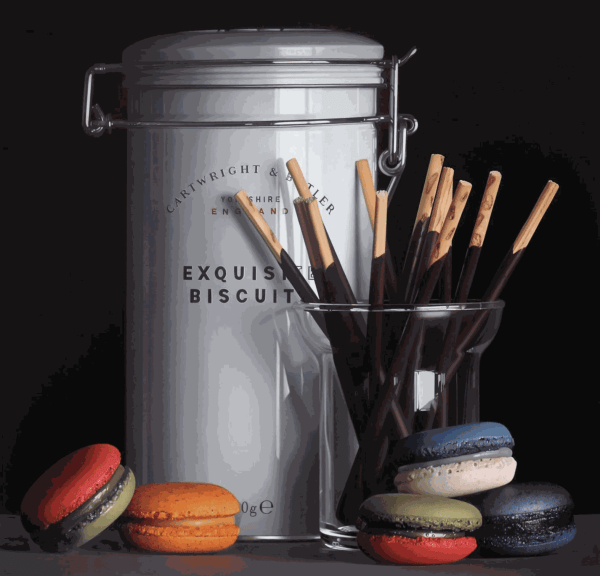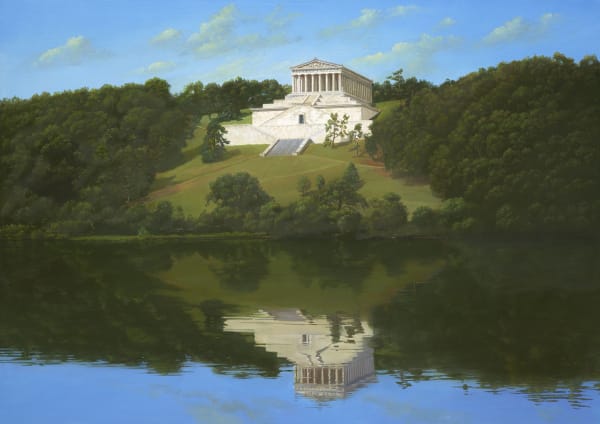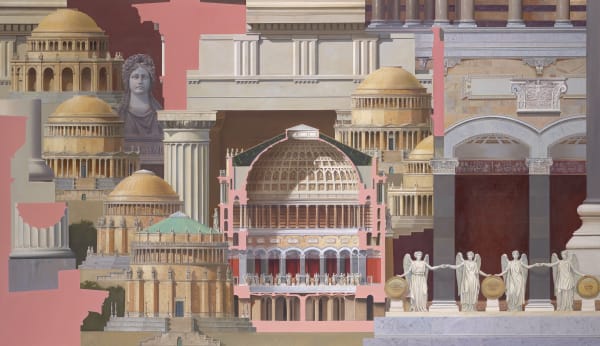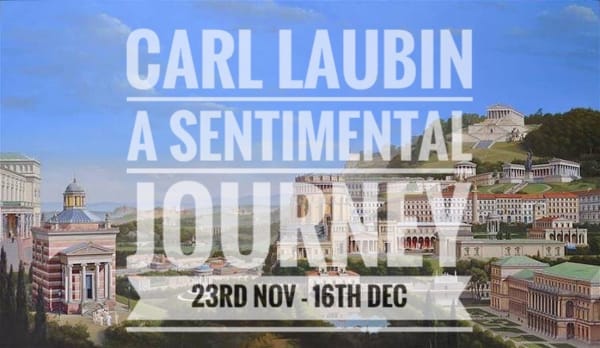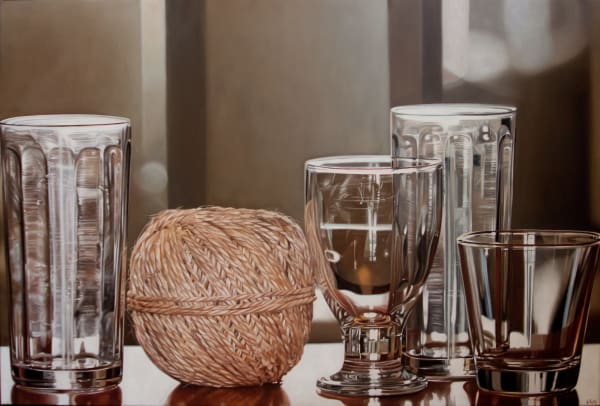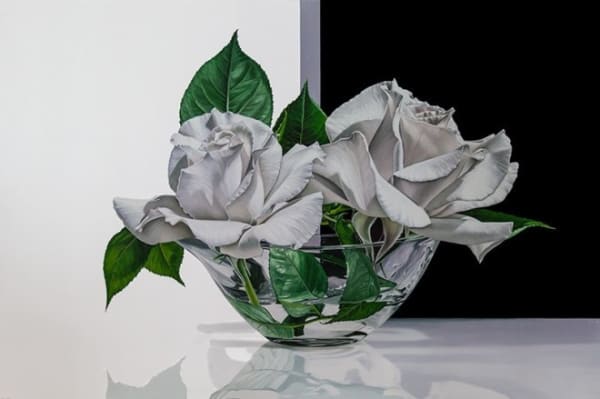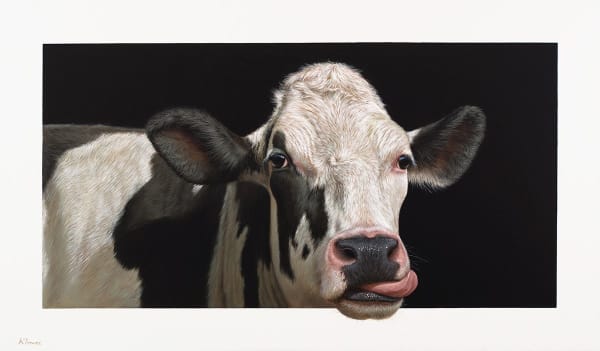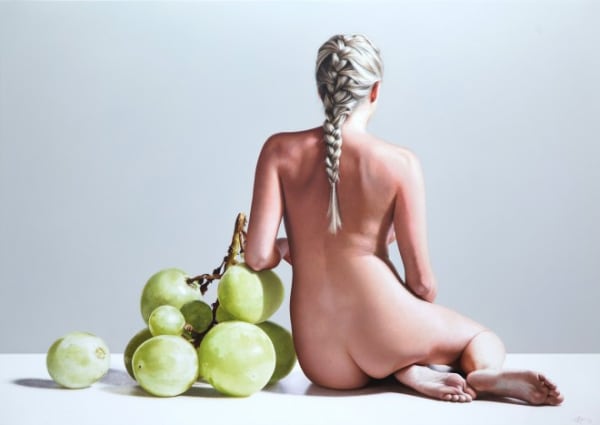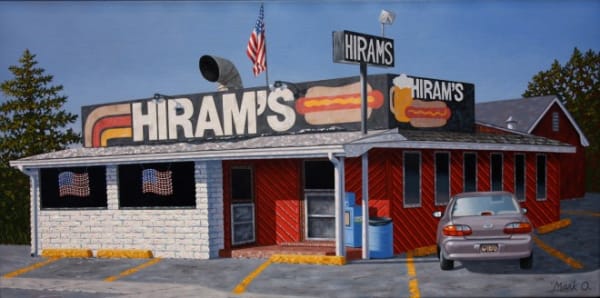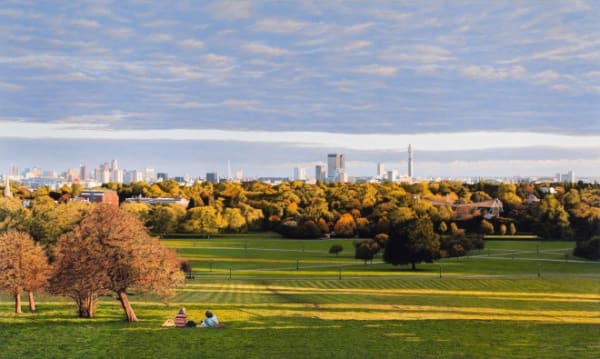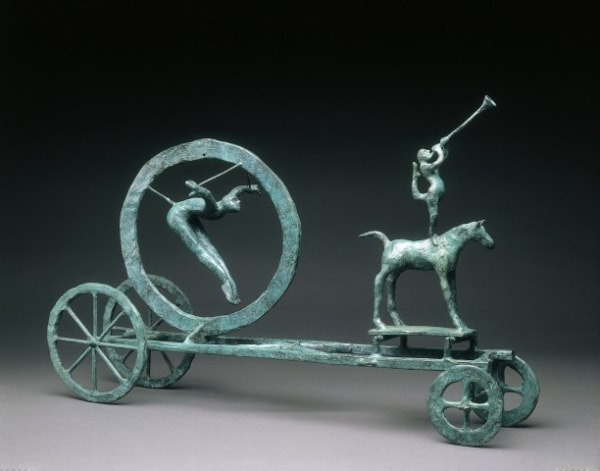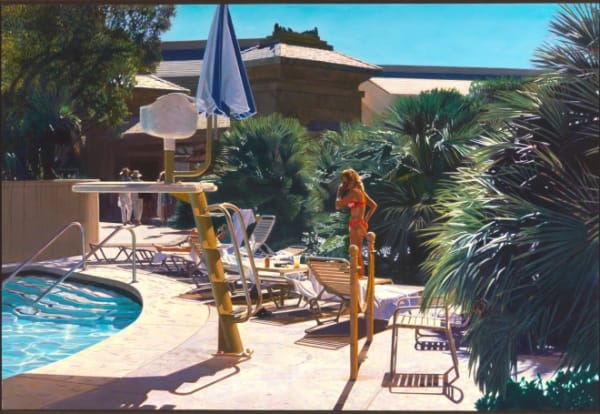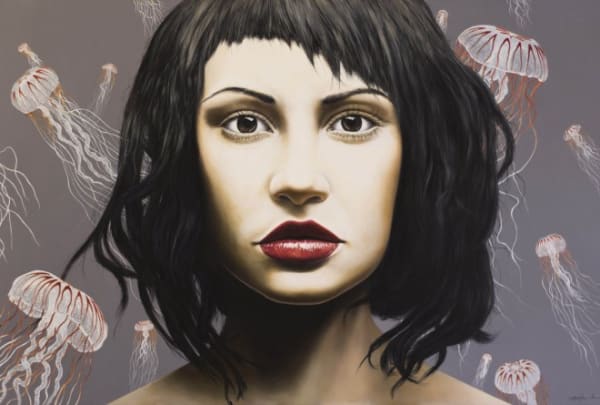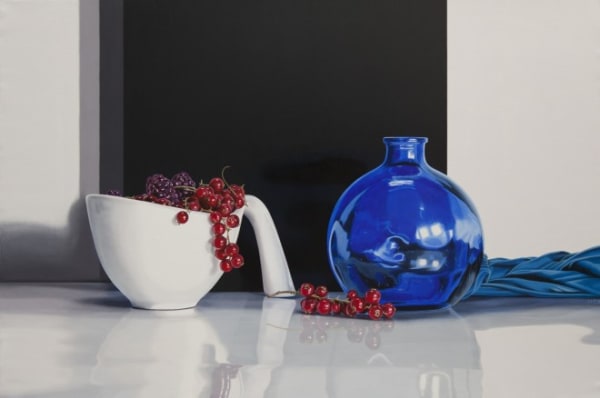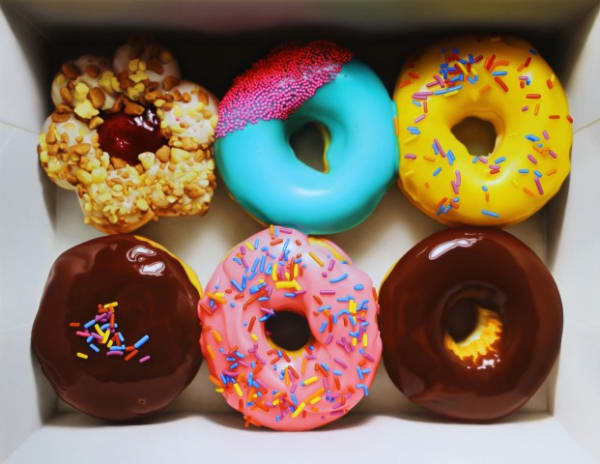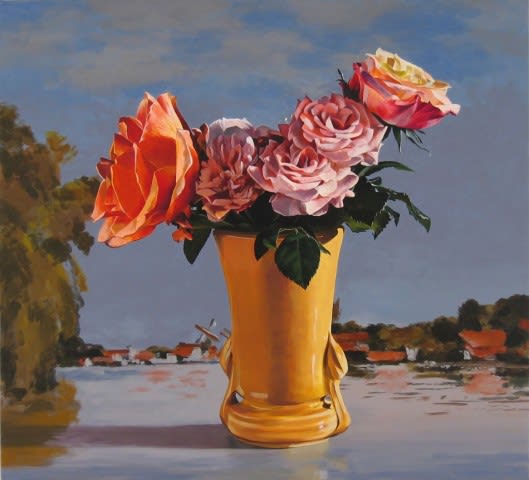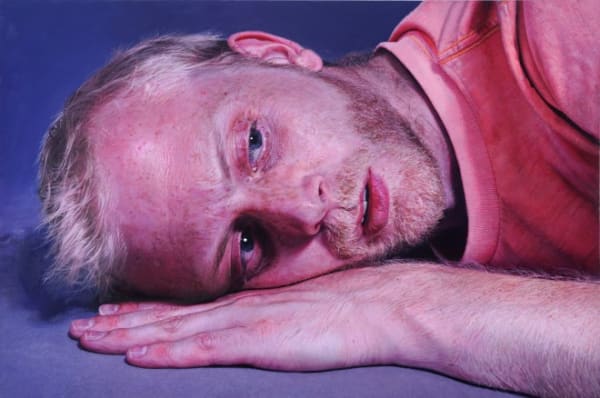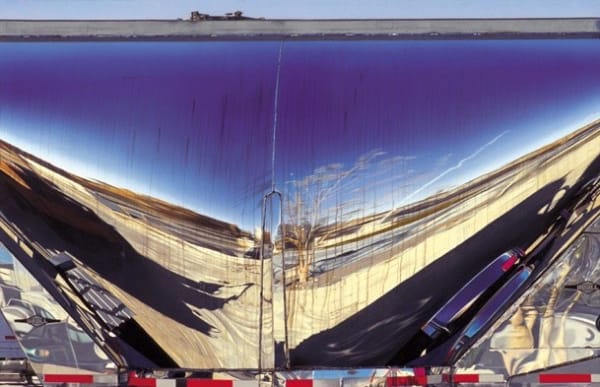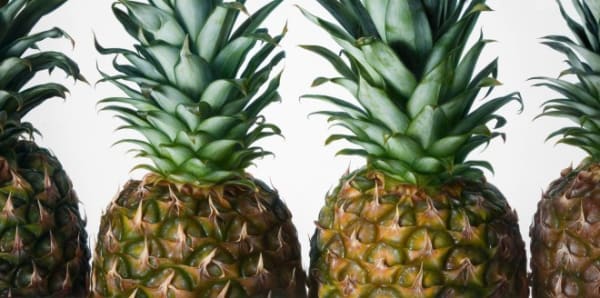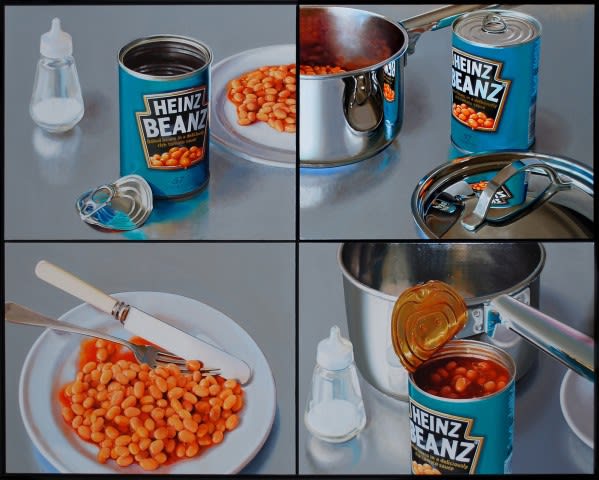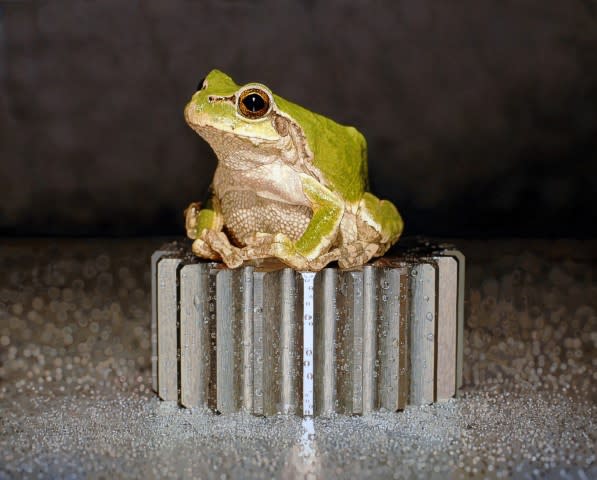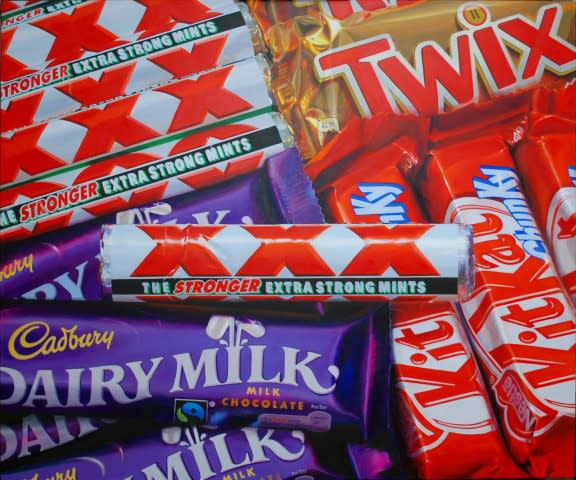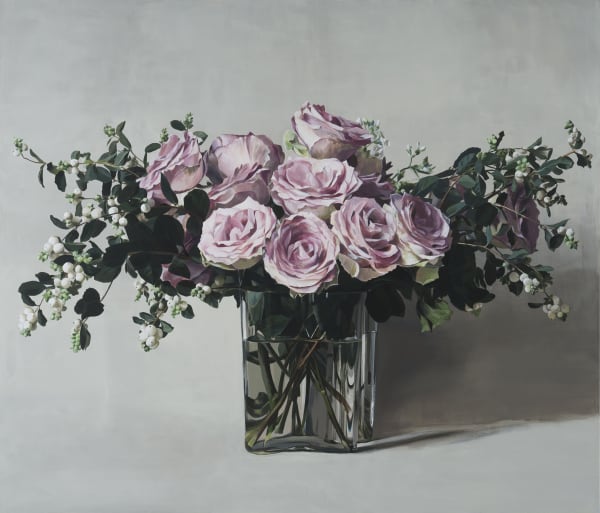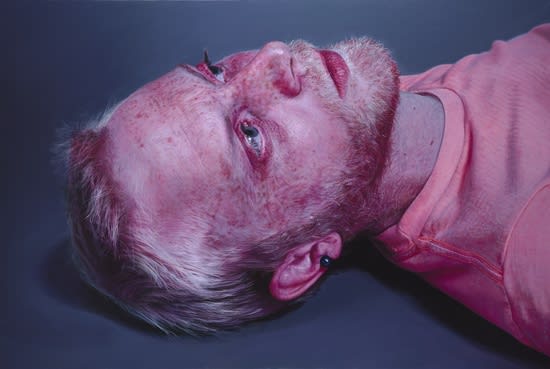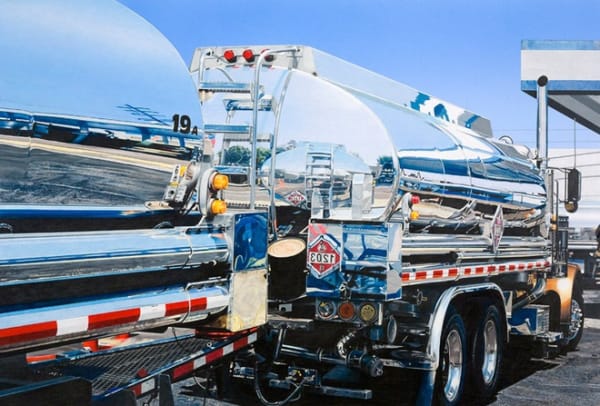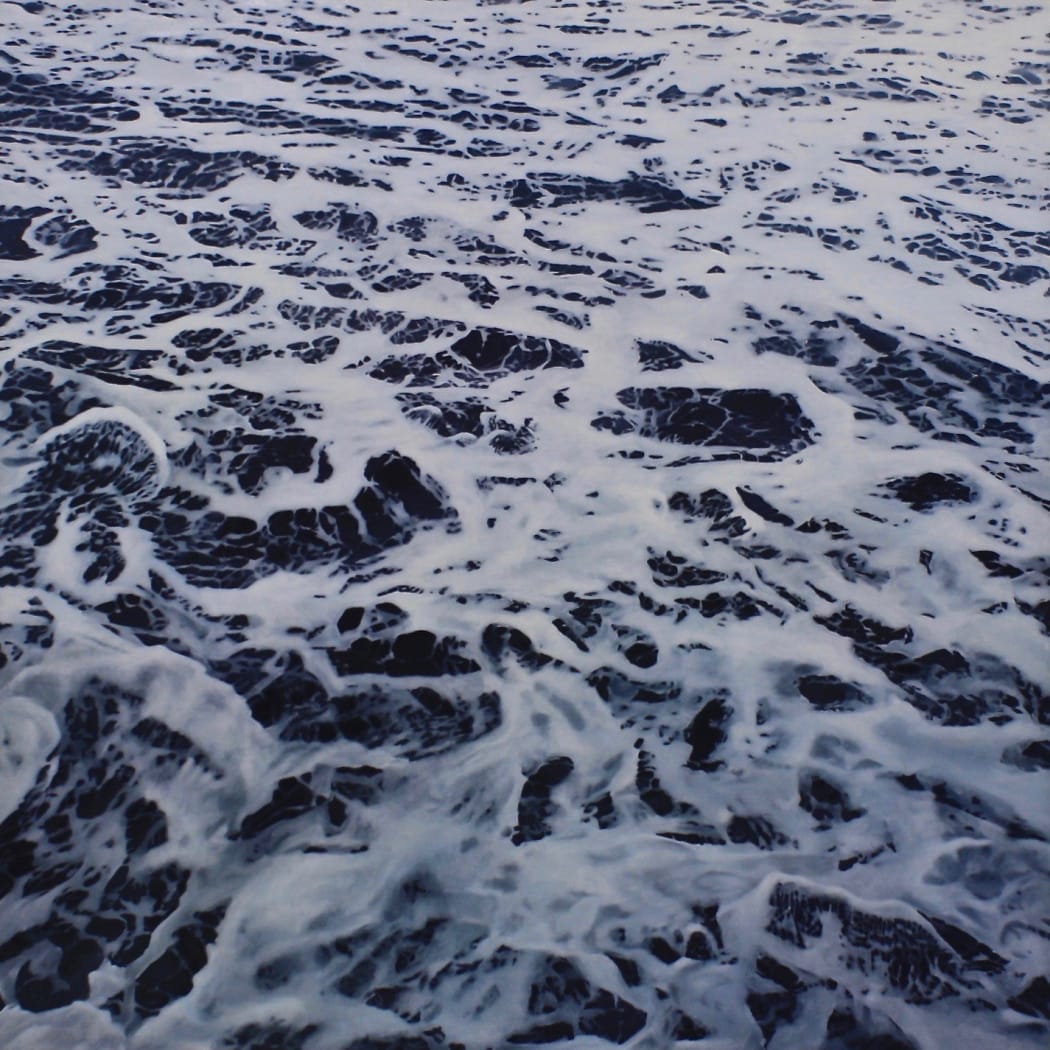
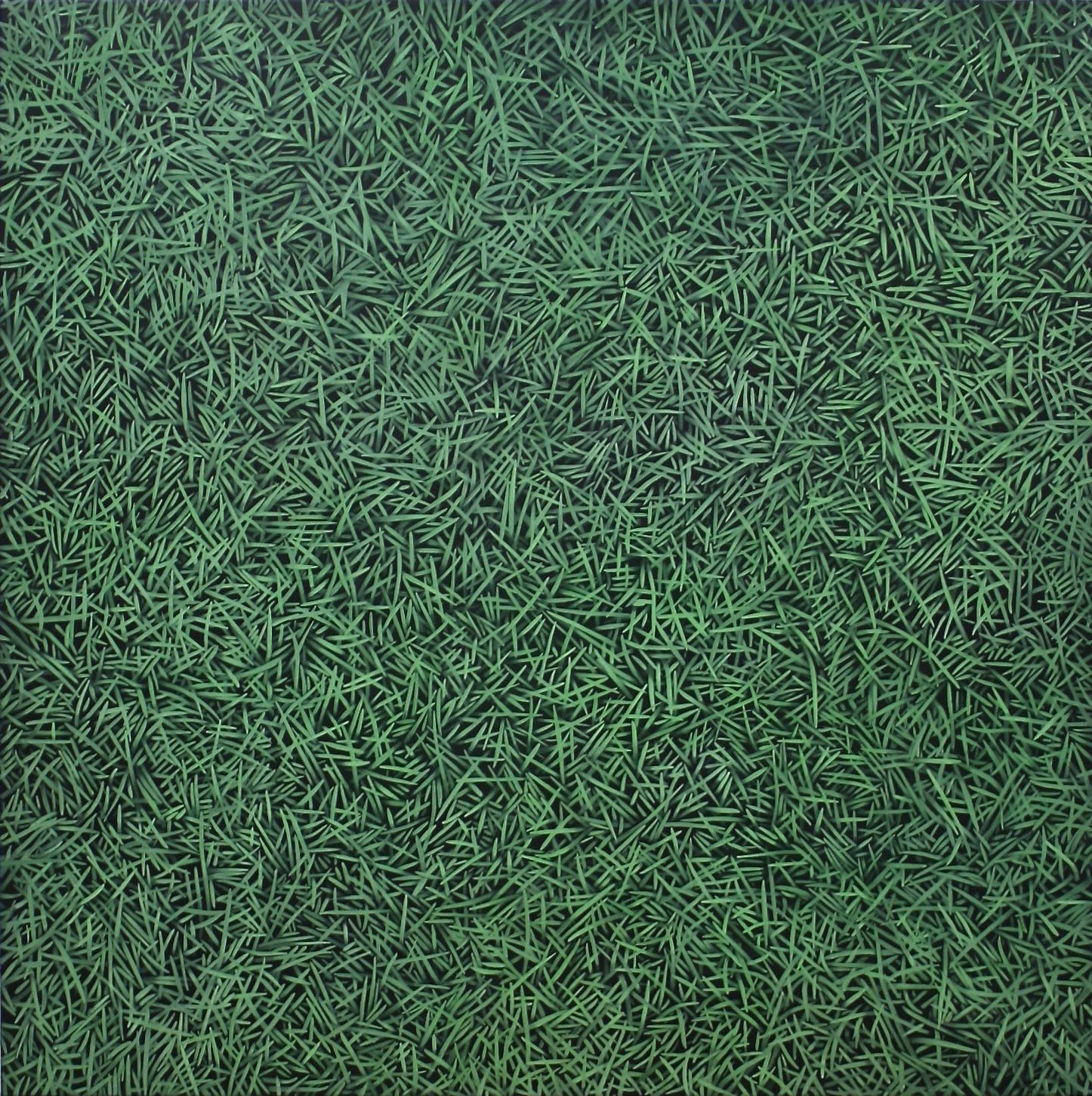
JKB Fletcher 'Always' oil on canvas, 150 x 150 cm
When did you become interested in Hyperrealism? How long have you been a hyperrealist artist?
I rather refer to myself as an artist interested in hyperrealism than a hyperrealist artist. I have always been interested in painting, but it was in Uni I developed a keen interest in photorealism and the complete mastery and discipline some artists could display. I actually don’t like most photorealism or hyperrealism works, however, I have a huge admiration for the discipline and concentration which goes into making these works. The issue, I think, is most of the paintings are happy not to address, or are unaware of, their pointlessness. I have recently become more interested in representational painting once I realised that the act of turning a photo into a painting is meaningless, this intrigues me and gives me reason to believe there is room to push the subject further.
What brought you to Plus One Gallery?
My friend Dan Smith who was working with Plus One at the time recommended me to them. They are a gallery that has stood the test of time, have dealt with some quality works and artists and I really enjoyed their book Exactitude; so, when they got in touch I was eager to join.
What’s integral to the work of an artist?
All my favourite artworks display an ability to both represent the time and milieu the work was made and the values of the artist who made it; without making direct reference to either.
Who is your favourite artist?
I have no way to answer this permanently, but currently I am buried in works by Rothko, Richter and Reyle.

JKB Fletcer 'Icelandic Ocean' Oil on canvas, 150 x 150 cm
The majority of your paintings tend to be painted on a square canvas’, what is it about this format that appeals to you?
I have a way of making rules for myself, like borders or parameters to work within; square canvases was one of the first. I started painting on square canvases as a necessity through university. They were a way to tie the works I painted together as they were all the same size, this meant I could paint cars, fish, household objects and skin, and the works would still relate to each other. Over time I found rules in the subjects I chose to paint, as well as the things I painted on, and this freed me up to paint on other formats other than a square. Now I am more likely to choose a composition for the image rather than an image for the composition but I feel very comfortable working on a square format.
The square cropping of a scene or image is now something we have become a custom to because of Instagram. Is this something you considered whilst creating your works?
I actually started it a few years before Instagram existed, but I later realised the relation between the visual link and I decided to make series of work based on images I found from the platform. I would find images that were trending at the time, like the ‘selfie’ the ‘duck mouth’ the ‘hot-dog legs’ etc. and I would turn them into paintings.
As a painter of realist images I would, as I’m sure most realist painters do, ask myself ‘why turn it into a painting?’ If an image works why then would you bother making it into a painting? The Instagram series was a way for me to look into that question further… I would take an image that was meant for a screen a few centimetres in width and height and make it almost a meter square. An image that was snapped at low-res and meant to be looked at for a few seconds then scrolled past, turned into something that took a hundred hours to complete and then hung on a white wall for weeks. We know if a painting is looked after it can last 800 years but no one is sure as to the safety and lifespan of these digital files on the servers that provide the life of these digital platforms. And finally, there was only one place you could see the painting at a time, when you were stood in front of it, whereas the images you found on Instagram could be found at any point no matter where you were just by a quick ‘search’. I found these things to be hugely influential to my art practice and even though I have no immediate plans to work any further on the Instagram series its effects continue to influence my current works.
How do you think apps such as Instagram have affected the creation and interaction of artworks, especially your own?
I really like some of these digital platforms and I would say Instagram is my favourite. I love how accessible the visuals are, with as little as two clicks I can be scrolling through a wall of images from sources I have chosen to follow. But I am also very aware of the fact that it is a separate thing to that of viewing artwork. I love that I can see what artist are up to and what a piece of their work may look like, but I know first-hand that being in front of a painting and looking at it on the computer or phone can hardly be considered the same experience. I could for example post a photograph posing it as a painting and people would react the same as if I had posted an image of a painting, because in reality there is no difference between the two when your only access to the work is through a digital device like that of your phone, you’re still just staring at your phone. Some artists are aware of this and in response use their Instagram as a tool to make artworks, or as a way to further push their ideas, others use it to document their practice. I think both are great uses of the platform but ultimately show how important documentation is overall.

JKB Fletcer 'DFE:2962.38' Pencil on paper, 32 x 50cm
You have recently started painting an ‘Earth Series’ depicting landscape, can you explain this move and how your painting will develop in the future…
My works are made with my situation in mind, what I like, where I’m from, where I am. The ‘Earth Series’ started by taking these literally as a base to start work. The photographs I paint from are all photos I have taken on my travels or from where I have worked or lived. Each of the paintings display very specific places on the planet yet just by looking at them it would be very hard to tell where they are. I think I did this at first unconsciously aware of the fact that I found comfort in seeing the sky, the water and the ground even so far away from what I considered home. No matter where I was I could photograph one or more of these subjects. This series is still in its early stages but has taken my full attention as it seems to have a lot of scope in other mediums as well as painting. The seasonal aspect of nature appeals to my daily routines and the detail in the images exercises my desire for challenges and at the same time a ‘hard work’ ethic that I often look for to justify the effort… It’s hard to say where the work will develop in the future but it is something I am looking forward to working on further.
You have recently started to work on drawings. What is it that drawing can offer that painting can’t?
When the ideas from the ‘Earth Series’ spread into other mediums; drawing and sculpture both seemed to lend itself to the ideas behind the works. With drawing I find the act to be more deliberate and final to that of a painting, there are no layers to build or colours to mix but just one tool striking across the surface caving a meaning into an otherwise meaningless piece of paper. I also find it easier to leave edges of the paper unfinished, something I have considered but never done with a painting, maybe this is because the drawings are quicker to make but this has meant that the drawings have offered something quite freeing to my art practice.
Your paintings are all within series, for example ‘Flesh’ and ‘Earth’. Is your intention for these artworks to be viewed together as a set?
No, it’s about the rules I make for myself, the boundaries I work and think within while making artworks. I like the idea of having a series shown together and I have done this in the past but hanging Flesh, Pixel or Earth works together isn’t something I would avoid, in fact I think it can only help to better understand the work and the motives.

JKB Fletcer 'Wrest', Oil on canvas 150 x 150 cm
How do you choose your subject matter, what is it that inspires?
I have a kind of checklist that I use before I start the work itself, things like ‘is it minimal in nature, organic, does it have an ambiguous quality etc.?’ But the ideas for the work happen as I work; I sketch the ideas down and I choose the ones that make the most sense to me when I am ready to start.
Your compositions are heavily cropped and so focus on small parts of a bigger picture. Why is this?
This stems from a love of minimalism, I prefer there to be just one subject in the image as most of the work I make isn’t about the subject I’m painting but the painting I have made when it is finished. I find one of the distractions to realist paintings to be, for example, that the landscape or face that is depicted are often a huge distraction from the painting itself, and the minimal, ambiguous imagery I choose is in response to this, in the hope to avoid it in my work.
If your audience could know one thing about your work or your practice, what would it be?
As mentioned earlier, my works are made with my own situation in mind, what I like, where I’m from and where I am. I suppose in the most obvious sense of attaching concepts to meaning I would have to say that I make work driven by the question ‘why bother turning it into a painting?’ If they ask this question to one of my works considering my inclination towards routine, minimal aesthetics and a disciplined practice, then perhaps they will find a reason why I make the work I make.
Related artist
- Tumblr
Add a comment
-
-
 Blog entries
Blog entriesHyperrealism Today
Article on Hyperrealism written by Maggie Bollaert published on EF Magazine -
 Blog entries
Blog entries7 Questions for Plus One Gallery Founder Maggie Bollaert on Why She’s Heralding the Next Generation of Hyperrealist Artists - Artnet Article
The London-based gallery has championed contemporary figurative art since 2001 -
 Blog entries
Blog entriesArtist in Focus - Mike Francis
1938 - 2023 -
 Blog entries
Blog entriesJohannes Wessmark for American Art Collector
-
 Blog entries
Blog entriesMeet the Photorealists
-
 Blog entries
Blog entriesCarl Laubin - Homage to Le Corbusier’s Pessac
-
 Blog entries
Blog entriesArtist in Focus: Ben Johnson
-
 Blog entries
Blog entriesGet Ready for Christmas with the Perfect Stocking Fillers
-
 Blog entries
Blog entriesArtist in Focus: Paul Beliveau
-
 Blog entries
Blog entriesAlexandra Klimas in Landleven Magazine
Alexandra Klimas paints in tribute to the animal -
 Blog entries
Blog entriesPOG's Christmas Suggestions
-
 Blog entries
Blog entriesHAPPY ANNIVERSARY PLUS ONE GALLERY
September 2001 - September 2021 -
 Blog entries
Blog entriesArtist in Focus: David Kessler
-
 Blog entries
Blog entriesArtist in Focus: Sergey Piskunov
-
 Blog entries
Blog entriesArtist in Focus: Alexandra Klimas
-
 Blog entries
Blog entriesLet's Get Ready for Christmas! - Volker Kuhn
November 30, 2020 -
 Blog entries
Blog entriesArtist in Focus: John Salt
-
 Blog entries
Blog entriesFeel Like We’re Living in Surreal Times?
Let These 5 Leading Hyperrealist Artists Ground You -
 Blog entries
Blog entriesAn Interview with Maggie Bollaert
For www.hyperrealism.net -
 Blog entries
Blog entriesArtist in Focus: Andres Castellanos
-
 Blog entries
Blog entriesThe Story Behind the Painting II: Alexandra Klimas
Hope the Donkey -
 Blog entries
Blog entriesCarl Laubin: Elegos
World Trade Centre – Ground Zero -
 Blog entries
Blog entriesAll You Need is Love!
-
 Blog entries
Blog entriesOur December Winter Picks
The ultimate cozy artworks for your living room this winter -
 Blog entries
Blog entriesArtist in Focus: Adolfo Bigioni
-
 Blog entries
Blog entriesThe Story Behind the Painting I: Denis Ryan
-
 Blog entries
Blog entriesArtist in Focus: Young-sung Kim
-
 Blog entries
Blog entriesHiperrealisme | 21 Jun - 30 Sept | Museu del Tabac, Andorra
-
 Blog entries
Blog entriesPlus One Gallery, The Piper Building
-
 Blog entries
Blog entriesHyperrealism: Resources for the Artist
-
 Blog entries
Blog entriesHappy Mother's Day!
She's looked after you all this time, make sure she knows she special! -
 Blog entries
Blog entriesWinter Show
January 17, 2018 -
 Blog entries
Blog entriesPhotorealism of the 1960s
January 10, 2018 -
 Blog entries
Blog entriesThe tradition of still life
November 29, 2017 -
 Blog entries
Blog entriesArtist in Focus: Javier Banegas
November 15, 2017 -
 Blog entries
Blog entriesArtist in Focus: Tom Betts
November 13, 2017 -
 Blog entries
Blog entriesJavier Banegas Private View
-
 Blog entries
Blog entriesNovember News
November 1, 2017 -
 Blog entries
Blog entriesArtist in Focus: Paul Beliveau
October 25, 2017 -
 Blog entries
Blog entriesYOUNG-SUNG KIM
October 18, 2017 -
 Blog entries
Blog entriesSeptember News
September 12, 2017 -
 Blog entries
Blog entriesArtist in Focus: David Kessler
-
 Blog entries
Blog entriesGallery News!
Simon Hennessey wins the acrylic paint category of the Jackson Painting prize 2017 -
 Blog entries
Blog entriesArtist in Focus: Paul Cadden
August 10, 2017 -
 Blog entries
Blog entriesArtist in Focus: Simon Harling
August 4, 2017 -
 Blog entries
Blog entriesArtist in Focus: Javier Banegas
July 21, 2017 -
 Blog entries
Blog entriesArtist in Focus: Francois Chartier
July 10, 2017 -
 Blog entries
Blog entriesAn Interview with Christian Marsh
June 21, 2017 -
 Blog entries
Blog entriesSummer Picks at Plus One Gallery
June 7, 2017 -
 Blog entries
Blog entriesPRIVATE VIEW
Tom Martin: Perpetual Motion May 17, 2017 -
 Blog entries
Blog entriesArtist in Focus: Andres Castellanos
-
 Blog entries
Blog entriesArtist in Focus: Steve Whitehead
-
 Blog entries
Blog entriesGallery News!
Carl Laubin is announced as the Winner of the 2017 Arthur Ross Awards for Excellence in the Classical Tradition, in te Fine Art Category. -
 Blog entries
Blog entriesWorks to Watch
Angus McEwan April 10, 2017 -
 Blog entries
Blog entriesPrivate View
Cynthia Poole: Gold Pieces & other Explorations -
 Blog entries
Blog entriesAn Interview with Cynthia Poole
March 30, 2017 -
 Blog entries
Blog entriesTom Martin : Sculptural Works
May 31, 2017 -
 Blog entries
Blog entriesAn Interview with Tom Martin
May 24, 2017 -
 Blog entries
Blog entriesArtist in Focus: Cynthina Poole
March 22, 2017 -
 Blog entries
Blog entriesArtist in Focus: Denis Ryan
-
 Blog entries
Blog entriesAn Interview with David Finnigan
-
 Blog entries
Blog entriesSpring Picks at Plus One Gallery
-
 Blog entries
Blog entriesArtist in Focus: Simon Hennessey
-
 Blog entries
Blog entriesPlus One Gallery's Top 5 picks this month
-
 Blog entries
Blog entriesWinter Show Private View
-
 Blog entries
Blog entriesWinter Show: Artists
An Interview with David Wheeler -
 Blog entries
Blog entriesWinter Show: Artists
An Interview with JKB Fletcher -
 Blog entries
Blog entriesWinter Show
-
 Blog entries
Blog entriesMERRY CHRISTMAS
from everyone here at Plus One gallery: Maggie, Colin, Rosie, Scarlett and Archie -
 Blog entries
Blog entriesA Sentimental Journey
Carl Laubin's journey in the creation of his solo show -
 Blog entries
Blog entriesNew destination on the Grand Tour
RIBA J article written by Hugh Pearman -
 Blog entries
Blog entriesAn Interview with Carl Laubin
November 30, 2016 -
 Blog entries
Blog entriesCarl Laubin: A Sentimental Journey Private View
With guest speaker Prof. Adrian von Buttlar -
 Blog entries
Blog entriesCountdown to the Carl Laubin Show!
Carl Laubin: A Sentimental Journey -
 Blog entries
Blog entriesNovember News
-
 Blog entries
Blog entriesElena Molinari Interview
Exhibition 'The Alchemy of the Everyday' runs until 19th November November 2nd 2016 -
 Blog entries
Blog entriesPrivate View: Elena Molinari: The Alchemy of the Everyday
-
 Blog entries
Blog entriesElena Molinari: The Alchemy of the Everyday
Invitation -
 Blog entries
Blog entriesElena Molinari: The Alchemy of the Everyday
October 7, 2016 Plus One Gallery is delighted to announce 'The Alchemy of the Everyday', the forthcoming solo show by Uruguayan gallery artist Elena Molinari. -
 Blog entries
Blog entriesWhat's New This October
October 4, 2016 It has been an exciting year so far and it doesn't look to be slowing down with some fabulous new works from the likes of Alexandra Klimas, Pedro Campos and Roger Watt. -
 Blog entries
Blog entriesAn Interview with Tom Martin
October 12, 2016 Plus One Gallery catches up with hyperrealist Tom Martin to discuss his creative process and why he is keen to distance himself from the restraints of a digital camera. -
 Blog entries
Blog entriesReinterpreting the American Dream in hyperrealism
October 5, 2016 -
 Blog entries
Blog entriesPlus One Gallery Official Opening Show
September 22, 2016 -
 Blog entries
Blog entriesOpening Show: Battersea Reach
September 15, 2016 We are excited to launch the opening show at our new premises in Battersea Reach where a range of exquisite hyperrealist art will be on display. -
 Blog entries
Blog entriesA trip down memory lane: Nostalgia in hyperrealism
September 8, 2016 Plus One Gallery examines nostalgia and hyperrealism, looking at vintage iconography, items and period images rendered in hyperrealistic art. -
 Blog entries
Blog entriesNew Artists: New Space
September 1, 2016 With the launch of our new premises at Battersea Reach, we are delighted to unveil the work of some of our latest artists. -
 Blog entries
Blog entriesAn interview with Christian Marsh
-
 Blog entries
Blog entriesArtist in Focus: Thomas Ostenberg
August 25, 2016 A closer look at the work of Thomas Ostenberg, whose sculptures explore the theme of motion and balance, reflecting his personal search for emotional equilibrium. -
 Blog entries
Blog entriesHow to find us at our new premises in Battersea Reach
August 17, 2016 To find Plus One Gallery, please follow these instructions and travel directions. -
 Blog entries
Blog entriesSunshine and seasides: Summer in all of its glory
August 10, 2016 The summer months breathe new life into the canvases of hyperrealists, as flowers come into full bloom and coastlines shimmer in the unwavering sunlight. -
 Blog entries
Blog entriesREMINDER: SUMMER SHOW PRIVATE VIEW
Tuesday 19th July, 6pm-8pm July 14, 2016 -
 Blog entries
Blog entriesHow is consumerist culture represented in hyperrealism?
June 29, 2016 Built around imagery of recognisable brands, celebrity cults and everyday life, consumerist art is rooted in the present social context. -
 Blog entries
Blog entriesPlus One Gallery Summer Show
June 27, 2016 -
 Blog entries
Blog entriesRelocation to Battersea Reach
June 23, 2016 -
 Blog entries
Blog entriesArtist in Focus: David Finnigan
June 22, 2016 British hyperrealist David Finnigan aims to present a style of realism that is both a progressive and experimental development of that genre. -
 Blog entries
Blog entriesAn interview with Elena Molinari
June 15, 2016 Born in Montevideo, Elena Molinari is best known for her still life paintings of fruit and vegetables, often placed in fruit bowls or alongside glass vases and silk cloths. -
 Blog entries
Blog entriesSweet temptation in Hyperrealism
June 9, 2016 Using a sensuous palette of colours and textures, many hyperrealist artists explore temptation, primal pleasures and how food can comfort the soul. -
 Blog entries
Blog entriesAn interview with Nourine Hammad
June 1, 2016 Plus One Gallery interviews hyperrealist artist Nourine Hammad about her unique artistic expression and process. -
 Blog entries
Blog entriesIn full bloom: flowers and their role in hyperrealism
May 25, 2016 Hyperrealists are refreshing the still life genre, invigorating paintings of flowers with contemporary techniques that challenge notions of tradition. -
 Blog entries
Blog entriesArtist in Focus: Craig Wylie
May 20, 2016 Craig Wylie has developed a multi-faceted but singular approach to hyperrealism that seizes the appearance of his subjects with tremendous fluency and ease. -
 Blog entries
Blog entriesGallery News: We are relocating!
May 17, 2016 -
 Blog entries
Blog entriesWhy painting maintains a significant role in a world of instant images
May 11, 2016 In a world where high-tech photography and instant photo messaging is available at our fingertips, what does hyperrealism give us that photography cannot? -
 Blog entries
Blog entriesA taste of your five-a-day in hyperrealism
April 27, 2016 Many hyperrealists explore fruit as a representation the transient nature of life, using colour to remind us of the inevitability of mortality and change. -
 Blog entries
Blog entriesThe influence of pop art in hyperrealism
April 13, 2016 Hyperrealism is often considered an advancement of Pop Art and Photorealism and first came to prominence at the turn of the millennium. -
 Blog entries
Blog entriesGALLERY NEWS: We are relocating!
April 7, 2016 -
 Blog entries
Blog entriesArtist in Focus: Mike Francis
Combining hyperrealism and commercial illustration April 6, 2016 Mike Francis is a photo realist, with a profoundly contemporary imagination, however his technique is deeply rooted in the Old Masters. -
 Blog entries
Blog entriesArtist in Focus: Christian Marsh
Humane landscape hyperrealism March 30, 2016 Christian Marsh's body of work consists of large scale paintings, which explore composite views of various cities around the world. -
 Blog entries
Blog entriesThe hyperrealist travel guide
March 28, 2016 Urban hyperrealism takes the modern metropolis as its subject. It challenges the artist to explore hidden meanings and diversity deeply rooted in society. -
 Blog entries
Blog entriesArtist in Focus: Young-Sung Kim
Challenging society's materialism March 16, 2016 Young-Sung Kim produces hyperreal paintings of contrasting subject matters to illustrate the differences between the living and the material. -
 Blog entries
Blog entriesArtist in Focus: Cynthia Poole
Examining consumerism with nostalgia March 9, 2016 Cynthia Poole’s paintings take food packaging, sweet wrappers and chocolate bars as their subject matter; often with a warm nostalgia for the 1980s confectionery. -
 Blog entries
Blog entriesMother's Day
-
 Blog entries
Blog entriesIs there a place for artistic interpretation in hyperrealistic art?
January 12, 2016 -
 Blog entries
Blog entriesHow does the use of photoshop affect hyperrealistic art?
December 16, 2015 -
 Blog entries
Blog entriesThe difference between Photorealism and Hyperrealism
November 25, 2015 -
 Blog entries
Blog entriesFive of the best hyperrealists on Instagram
November 4, 2015 -
 Blog entries
Blog entriesNew media being used for hyperrealism
Plus One Gallery explores the new media being used within hyperrealism pieces. -
 Blog entries
Blog entriesCities in Real Life: Urban Hyperrealism
Plus One Gallery examines the impact of street culture, through urban art, and its effect on artistic expression within hyper realism pieces. -
 Blog entries
Blog entriesA Brief History of Hyperrealism
August 7, 2015 Plus One Gallery recaps Hyperrealism with a brief look at the historical influences and movements that led to modern day hyper realistic art.
-



